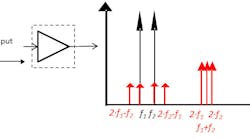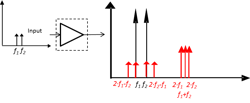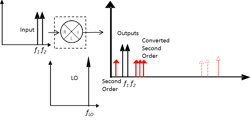This file type includes high resolution graphics and schematics when applicable.
Every day we work on high linearity mixers: high IP3, high P1dB, and high spurious suppression. Every once in a while we get a request for a high IP2 mixer. This is much more rare than complaints about IP3 or spurs. Lets see why.
To start understanding IP2 in mixers, lets look at intermodulation products in amplifiers. Start by imagining a single tone into a single non-ideal amplifiers, with a nonlinearity.
A single input tone is amplified to a larger tone, as desired. Due to the nonlinearity in the amplifier, higher order tones are created. These are only created at integer multiples of the input tone, since the system is time invariant. These decrease in power as the frequency increases, and they are generally referred to as second, third, Nth order distortion products.
A new problem arises if we put two tones into the same amplifier:
This diagram only shows the second harmonics, the second order intermodulation, and the third order intermodulation in the relevant bands. As you can see, the second harmonics (at 2f1 and 2f2) are easily filtered out as they are at a very high frequency, unless you are in a very broadband multioctave system. The second order intermodulation (at f1 + f2) is in between the two harmonic distortion products, so it is also easily filtered except in broadband systems. While these are drawn as the same power level, they are not necessarily the same power in practice. The third order harmonics (at 2f1 - f2, f1 + f2 - f1, f1 + f2 - f2, and 2f2 - f1) are all famously in band. Two of the tones are directly on top of the desired received tones, and therefore they cannot be filtered even with an infinitely narrow and steep filter.
Now to mixers. The addition of the time varying LO increases the complexity dramatically. All of the previous effects will be present, and also will all be present at the LO crossed frequencies. For the moment lets ignore everything but the isolations, fundamentals, and second order distortions (both single and multitone).
In this case, there are two types of second order products: direct and converted. The direct products are at the same frequency as in an amplifier, and the converted second order product is between the 2IF × 1LO products. Again these are drawn as the same power level, but they may or may not be identical powers.
When will these products matter? The converted products will appear in the passband in a broadband system (with a low IF) where they cannot be filtered out. Conversely the direct second order products will matter in a different kind of broadband system, with a high IF. Specifically when fIF = 1/3 fLO, the converted signal and the second harmonic of the IF, and the second order distortion product, will all be at 2/3 fLO. These can be a problem, but usually no worse and closely affiliated with the 2IF × 0 LO spur.
So in both cases we see that while the second order distortion exists, it is always close to a high power spur that also must be dealt with in the frequency plan.
Now lets consider a downconversion:
Once again the converted second order shows up, this time in between the two 2LO – 2RF spurs that usually wreak havoc on downconversion systems. Once again the same frequency plan is needed to eliminate it. The direct second order term, however, is at f2 - f1, which becomes a significant problem when the IF frequency is similar in magnitude to the separation between the two tones. In this case the direct second order tone would lie directly over one of the tones.
The converted two tone second order intermodulation product will be an issue in the same circumstance as the 2× - 2 spur is a problem, namely when you have a low IF. If the IF is at DC (direct downconversion) then the second order intermodulation will cause significant distortion at DC. This is why the most common reference to IP2 in the literature is for the mitigation of it in direct downconversion receivers.
One thing that is not IP2, but is sometimes referred to as IP2, is the half-IF spur. This occurs when a signal (at Frf) is downconverted to a low frequency, near baseband, and there is a jamming signal at a frequency (Fj) roughly halfway between the RF and LO frequencies. The downconverted jamming signal can be filtered out by the IF filter, along with all other unwanted signals. However, the jammer signal creates a high power 2 LO x 2 RF spur, however, that will show up at or near the desired signal, and there is no physical way to filter it out.
However, this is not a two tone IP2 problem. It is simply a second order distortion product. So I shouldn’t take these authors too hard to task. As Joel Dunsmore cautions in his book, Introduction to "Microwave Measurements":
There is sometimes confusion in the use of the term second-order intercept; while it is most commonly used to refer to the second harmonic content, in some cases, it has also been used to refer to the two-tone second-order intercept, which is a distortion product that occurs at the sum of the two tones. Most properly, one should always use the term two-tone SOI if one is to distinguish from the more common harmonic SOI.
And that is the final point of this post; when you are talking about IP2, you always need to be specific about what you mean.
This file type includes high resolution graphics and schematics when applicable.







